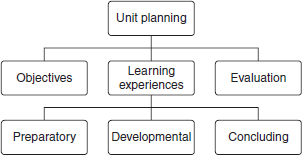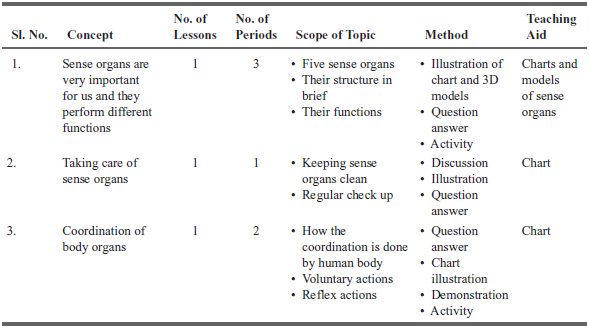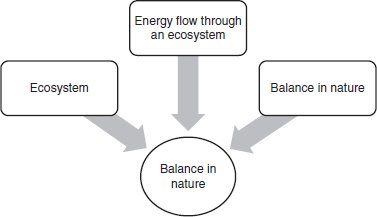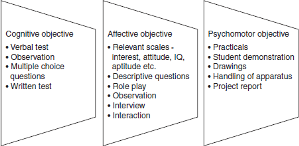5
Unit Planning and Lesson Planning
CHAPTER OUTLINE
LEARNING OBJECTIVES
After reading this chapter, you will be able to:
Comprehend the two stages of science teaching
Explain unit planning and its steps
Make a performa of unit plan
Describe a lesson plan
Elaborate on the approaches and forms of lesson planning
Compare Herbartian, Bloom and RCEM approaches to lesson planning
Prepare lesson plans on the basis of formats of three types of lesson plans
List the advantages of a unit plan and a lesson plan
INTRODUCTION
An important aspect of teaching relates to planning and conducting daily lessons. Majority of the teachers decide about teaching on the basis of the subject matter given in the prescribed text books. There are some teachers who take an initiative to include the daily life experiences of children in their regular teaching. For teaching a particular class, a science teacher needs to plan it in stages. There are two stages of science teaching—stage I is planning of a unit and stage II is planning of a lesson. The whole subject matter is organized into units and units are divided into lessons to have varied activities in the teaching.
UNIT PLANNING
- What Is a Unit?: A unit is a long term plan which is a part of the instructional planning. A unit plays an important role in learning because it has many meaningful activities related to each other. These activities provide a purposeful learning experience and the learner understands the whole concept. Thus, a unit takes care of the logic of the subject matter as well as the psychological considerations of the learner i.e., needs, interests and abilities of the learner. Thus, a unit is a body of information and experience which leads to significant outcomes in a learner.
- Steps of Unit Planning
A unit generally consists of three parts (Figure 5.1)

Figure 5.1 Steps of Unit Planning
- The objectives
- The learning experiences for the learner
- Evaluation to analyse the achievement of the objectives.
- Objectives: The objectives are stated in terms of the understanding and ability of the learner. Development of an attitude and appreciation is also a part of these objectives.
- Learning Experiences: Learning experiences or activities help in the attainment of the decided objectives. A range of activities suitable for both individual and group work are planned. These may be of three types:
- Preparatory: These experiences or activities may be used to assess the abilities of the students or to orient and motivate them for purposeful future activities. These experiences are preparatory in nature.
- Developmental: After preparation comes the development part in which the experience enables the pupils to acquire skills, attitudes and understanding. Such experiences are called developmental experiences and they involve discussion, problem solving, innovation, project, field work, etc.
- Concluding: To assess whether the activities have been successful or not, culminating experience is planned. These may include assignments, reports, records, recapitulatory activities, etc.
- Evaluation: In the end, to assess the achievement of objectives, evaluation is carried out. Evaluation enables to find out the extent of objective attainment and the direction in which the development of students have taken place.
- Performa for Unit Plan: A performa which could be helpful in planning a unit is being illustrated in the Figure 5.2, with the help of an example:

Figure 5.2 Performa of a Unit Plan
- Composition of a Unit: All the related topics of the syllabus are grouped into small sections. Many books available in the market follow this pattern, but still, some books just have all the chapters together. Grouping the related topics into smaller sections or units makes it easier for the students to follow them, as they serve the purpose of interest and comprehension for students. Working in units gives motivation, as the successful completion of a unit provides reinforcement. It must be kept in mind that to complete one unit many lessons may be required. All the lessons are connected to each other. Each lesson is a part of the whole unit and leads to the development of next lesson in the unit. Completion of one unit may require many types of learning experiences. The composition of a unit is being given here (Figure 5.3).

Figure 5.3 An Example of a Unit and Its Lessons
- Advantages of Unit Planning:
Following are the advantages of unit planning:
- The teacher decides about the instructional programme which is carried out by students in co-operation with the teacher and the other students.
- Learning is more integrated.
- A variety of activities take care of the individual differences among students.
- Learning is done by students according to their will and is not forced upon them.
- Critical thinking and problem solving skills are developed.
LESSON PLANNING
- What is a Lesson Plan?: A lesson is a guide map or a blue print of action in the class for one period. Planning of this lesson for a period of 35–40 minutes is called lesson planning. In other words, lesson planning refers to sequential organization of teaching acts or events that are planned and carried out to create learning atmosphere in the class. Generally, teaching is organized in three phases—pre-active, interactive and post-active. Lesson planning is a part of pre-active phase. A well planned lesson gives a sense of security and confidence to the teacher. The dictionary of education defines a lesson plan as a teaching outline of the important points of a lesson arranged in the order in which they are to be presented. It may include objective questions to be asked, references to materials, evaluation, assignments, etc.
Thus, lesson planning is a short-term plan which should have the following:
- Aims and objectives
- Previous knowledge
- Introduction
- Development or presentation
- Evaluation
- Summary or recapitulation.
- Approaches to Lesson Planning
There are many approaches to lesson planning which are being discussed here:
- Herbartian approach: It was given by J.F. Herbart and is based on ‘Apperceptive Mass Theory of Learning’. A student is considered to be a clean slate and all the knowledge is given from outside. If the new knowledge is based on previous knowledge of the student, it may be acquired easily and retained for a longer period. The teaching content should be presented into a unit which should be arranged in a logical sequence. There are five steps of lesson planning:
- Introduction
- Presentation
- Organization
- Comparison
- Evaluation
Herbartian approach lays too much emphasis on content presentation.
- Project Approach: This approach was developed by an American pragmatist John Dewey and W.H. Kilpatrick. It emphasizes that the knowledge of students should be related to their daily life situations and should enable the child in solving their problems. A project is a whole hearted purposeful activity taking place in a social environment. The steps of the project approach have been given in the chapter on ‘Methods of Teaching Science’. The project approach stresses on self-activity, social efficiency and experience of real life situations.
- Unit Approach: Unit approach, given by H.G. Morrison, is more psychological in nature and is a learner-centered approach. It emphasizes more on learning objectives and the needs of students. The unit approach has proposed a ‘Cycle Plan of Teaching’ which has five steps:
- Exploration
- Presentation
- Assimilation
- Organization
- Recitation
It stresses on assimilation aspect of a learner, i.e., whatever a student understands is more important than whatever a teacher transacts.
- Evaluation Approach: B.S. Bloom developed this approach of lesson planning. He considered education as a tri-polar process with the three poles as—educational objectives, learning experience and change of behavior. It suggests three steps of lesson planning which are:
- Formulating educational objectives
- Creating learning experiences
- Evaluating the change of behavior
This approach considers teaching as objectives centered rather than content centered and therefore, evaluating the change in behaviour of students is the most important. Due to the emphasis on testing of teaching, this approach is known as evaluation approach. On the basis of the data collected for the change of behaviour of students, the objectives of learning can be modified and accordingly the learning experience can be revised and improved.
- Herbartian approach: It was given by J.F. Herbart and is based on ‘Apperceptive Mass Theory of Learning’. A student is considered to be a clean slate and all the knowledge is given from outside. If the new knowledge is based on previous knowledge of the student, it may be acquired easily and retained for a longer period. The teaching content should be presented into a unit which should be arranged in a logical sequence. There are five steps of lesson planning:
- Forms of Lesson Planning: On the basis of approaches discussed above, there are various forms of lesson plans. For any form of lesson plan, a teacher needs some basic information about the class, students, and their previous knowledge. Generally, a lesson is divided into many steps and these steps are used during lesson plan development. Different forms of lesson plans are followed in different countries, but in India the three most popular and commonly used forms are those which are based on Herbartian approach, RCEM approach and Evaluation approach.
- Lesson Plan on the Basis of Herbartian Approach: Herbartian approach given by John Fredrik Herbart has five steps, namely, introduction, presentation, organization, comparison and evaluation. An outline of the lesson on the basis of these five steps is as given below:
- Information regarding subjects, topic, class, date, period, duration.
- Instructional objectives: These are further divided into two sub-headings:
- General objectives: General objectives are different at the different levels of schooling. These are long-term objectives and cannot be achieved in one period. They are decided for the whole year and teaching of science throughout the year leads to the achievement of these general objectives.
- Specific objectives: Specific objectives are written in behavioural terms as they focus on the learning outcomes of teaching in one particular period. These specific objectives may be related to knowledge, skills and appreciation and must be measurable and observable. They must also be written in clear language so that the science teacher can plan the essential teaching-learning activities.
- Teaching aids: Those teaching aids are selected by the science teachers which are needed to clarify the concept. All the teaching aids which may be in the form of charts, models, real specimens, demonstration material, etc. should be listed in the lesson plan.
- Previous knowledge: A science teacher needs to assess the previous knowledge of students before the lesson planning. This knowledge base of the students enables the teacher to introduce a lesson and also to decide about the classroom activities. Previous knowledge of the students can be tested with the help of direct questions.
- Introduction: A topic can be introduced by the science teacher through introductory questions or by putting up a suitable situation. Introduction of the topic prepares the students to receive new knowledge and helps them to link the newly acquired knowledge with their previous knowledge.
- Presentation: It comprises of the presentation of content to the class. This is generally done with the help of developmental questions. The answers of these questions lead to the teaching point and its explanation by the teacher. Developmental questions are arranged in a logical sequence and make the classroom situation interactive. The interaction during presentation also depends on the teacher's communication skills and skills of questioning, explaining, demonstrating, etc.
- Recapitulation: Recapitulatory questions are asked to find out the extent of learning which must have taken place during one period of teaching. Recapitulation provides feedback to a teacher about his/her teaching process and also enables the evaluation of the comprehension level of students.
- Blackboard summary: It is about the teaching points and their explanation. Teacher plans and writes the summary of teaching points and other key words of the lesson in the lesson plan. These are written on the black board simultaneously along with the lesson development.
- Home assignment: It is the concluding part of the lesson plan in which home work is given to the students. It must include thought provoking questions or activities. Home assignment ensures the revision and practice of the topic by the students. During practice, they get the chance to assimilate whatever they have learnt during the class.
- Lesson Plan on the Basis of Bloom's Evaluation Approach: The evaluation approach is a relatively new innovation in the field of education. Bloom has considered education as a tri-polar process in which three poles are—educational objectives, learning experiences and change in behaviour. (Figure 5.4)

Figure 5.4 Three Poles in the Educational Process
This approach has brought a revolution in the teaching-learning process. All the educational activities are objective centered and the main objective is bringing about a change in the behaviour of students. Thus, in this approach a students’ performance is measured in terms of learning objectives and not the achievement of the content. There are three steps of lesson planning in evaluation approach which are as follows:
- Formulating educational objectives: There are three domains of educational objectives—cognitive domain, affective domain, and psychomotor domain. These have been discussed in detail in the chapter on ‘Aims and Objectives of Teaching Science’. While writing the educational objectives, the science teacher should consider the course content, student level, infrastructural facilities at school, economic conditions, etc. The objectives are written in behavioural terms, i.e., in terms of the change in behavior.
- Creating learning experiences: On the basis of learning objectives, suitable teaching strategies and teaching aids are selected which constitute the learning experiences. These experiences are generally provided in the school. The teacher carries out the activities to bring the behavioural change in the students and these activities are related to learning outcomes. For each teaching objective, learning experiences are different. (Figure 5.5)

Figure 5.5 Teaching Objectives and Related Learning Experiences
- Evaluating change of behaviour: Learning experiences bring about desirable change in the behaviour of students. This change of behaviour is of three types—cognitive, affective and psychomotor. A test is prepared to measure all the objectives. This test includes different types of questions for measuring different types of objectives. (Figure 5.6)

Figure 5.6 Learning Objectives and Related Evaluation Techniques
- Lesson Plan on the Basis of RCEM Approach: RCEM stands for Regional College of Education, Mysore and thus RCEM approach is the style of lesson planning developed by Indian educationists at Mysore. This approach is a combination of Herbartian approach and Bloom's approach. There is equal emphasis on both, the learning objectives as well as the content to be taught. The three steps of lesson planning as per RCEM approach are:
- Input: It includes the identification of objectives in behavioural terms. The identified objectives are known as Expected Behavioural Outcomes (EBOs).RCEM approach uses Bloom's educational objectives with a little modification. Bloom has given 6 categories of cognitive domain, whereas, RCEM has given 4 categories. Analysis, synthesis and evaluation of Bloom have been put under one category, i.e., creativity. Thus, these objectives are categorized into four heads—knowledge, understanding, application and creativity. The expected behaviour of students is also identified. These instructional objectives help in sequencing of instructional procedure as well.
- Process: It is an interactive stage where the teacher is in the classroom and going ahead with the teaching process. The teacher needs to select the teaching strategies, communication techniques and audio-visual aids for effective presentation of the content. The main focus in this step is on creating learning situations. During these situations, the interaction between students and teacher takes place which motivates the students. Thus, the resultant learning experience brings about a change in the student's behavior.
- Output: This step includes the real learning outcomes (RLOs). During the ‘process’ step mentioned above, behavioural changes occur in students. This change of behaviour is also known as real learning outcomes. RLOs are measured by oral and written questions.
- Lesson Plan on the Basis of Herbartian Approach: Herbartian approach given by John Fredrik Herbart has five steps, namely, introduction, presentation, organization, comparison and evaluation. An outline of the lesson on the basis of these five steps is as given below:
- Formats of Lesson Plans:
- Herbartian Lesson Plan Format
Date: Subject: Class: School: Topic: Period: Duration: - Bloom's Lesson Plan Format
Date: Subject: Class: School: Topic: Period: Duration: - RCEM Lesson Plan Format
Date: Subject: Class: School: Topic: Period: Duration: - Concepts
- Teaching Aids
- Previous Knowledge
- Introduction
- Statement of the Topic
- Presentation

- Blackboard Work (To be done along with teaching)
- Home Assignment
- Herbartian Lesson Plan Format
- Advantages of Lesson Plan
The advanteges of a lesson plan for the teaching of science are as below:
- It is helpful in developing the teaching skills during practice teaching of B.Ed. course.
- It assists in the organization and planning of teaching.
- Pre-service and in-service teachers, both are benefitted from lesson planning.
- It helps in the management of time during teaching.
- Theoretical concepts can be applied to practice by lesson planning.
- Lesson planning is instrumental in the training of pupil teachers.
SUMMARY
- A science teacher needs to plan his/her teaching in 2 stages:
- Unit planning
- Lesson planning
- There are three steps of unit planning:
- Objectives
- Learning experiences
- Evaluation
- A unit is composed of lessons on related topics.
- A unit is a body of information and experience which leads to significant outcomes in a learner.
- A lesson plan is a guide map or a blue print of actions in the class for one period.
- A lesson plan should have the following:
- The four approaches to lesson planning are:
- Herbartian approach by Herbart
- Evaluation approach by Bloom
- Unit approach by Morrison
- Project approach by Dewey
- On the basis of the various approaches, forms of lesson plans have been proposed. In India, three forms of lesson plans are used which are:
- Lesson plan on the basis of Herbartian approach
- Lesson plan on the basis of Bloom's approach
- Lesson plan on the basis of RCEM approach
- A lesson plan is helpful in developing the teaching skills during practice teaching of B.Ed. course and assists in the organization and planning of teaching.
QUESTIONS
- What is the difference between a unit plan and a lesson plan?
- Describe the three steps of unit planning.
- Why should science teachers make lesson plans?
- Make a performa of unit plan for any unit of your choice.
- What do you understand by lesson planning? Describe various approaches to lesson planning
- Explain the forms of lesson plans on the basis of Herbartian approach, Bloom's approach and RCEM approach.
- Prepare lesson plans based on the three approaches of lesson planning.
- Why is lesson planning needed by a science teacher?


